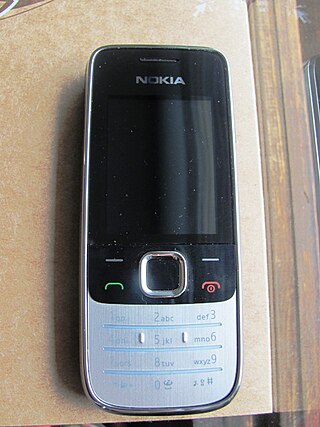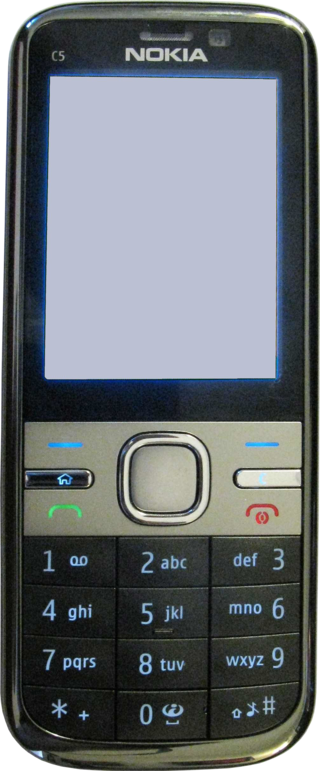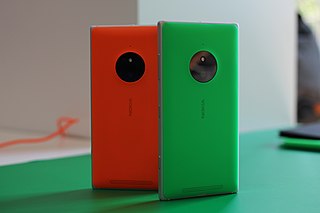
The Nokia 6230 is a mobile phone based on the Nokia Series 40 platform. It was announced on 28 October 2003 and released in February 2004.

The Nokia 3250 is a mobile phone running Symbian OS v9.1, announced on 26 September 2005. It features a unique 'twist' design that transforms the traditional phone keypad into a camera and dedicated music control keys. It was marketed as a music phone and can store up to 2 gigabytes of music and other data thanks to a microSD memory card slot, and features a two-megapixel camera as well as other smartphone capabilities.

The Nokia N95 is a mobile phone produced by Nokia as part of their Nseries line of portable devices. Announced in September 2006, it was released to the market in March 2007. The N95 ran S60 3rd Edition, on Symbian OS v9.2. It has a two-way sliding mechanism, which can be used to access either media playback buttons or a numeric keypad. It was first released in silver and later on in black, with limited edition quantities in gold and purple. The launch price of the N95 was around €550.

The Nokia 6300 is a mobile telephone handset produced by Nokia. It was announced on 28 November 2006 and released in January 2007. This model was assembled in several factories, including Jucu plant, near Cluj, in Romania.
The Nokia 6275i is a CDMA mobile phone. Basically, it is a "candybar" version of the Nokia 6265. It has a 2.0-megapixel camera with flash, and a portrait mirror. The phone itself has 21 MB of memory, but it can use microSD cards to expand the memory capacity to 2 GB. It uses the Nokia Series 40 OS, and can connect to other devices using infrared, USB, and Bluetooth technology. The screen has a resolution of 240x320.

The Nokia 6120 classic is a mid-range mobile phone from Nokia that was announced on 17 April 2007. It runs on Symbian v9.2 with a S60 3rd Edition FP1 user interface.

The Nokia 3110 classic is a mobile phone handset, manufactured by Nokia in Hungary and released for sale in 2007. It is a budget model with similar features to the Nokia 6300. Although the phone bears the same model number as the 1997 Nokia 3110, it was not directly derived from this model.
The Nokia 6000 series or Classic Business series is range of mobile phones marketed by Nokia. This family of phones is notable for their conservative, unisex designs, making them popular with business users.

Nokia 5300 XpressMusic is a slider mobile phone by Nokia, part of the XpressMusic range. It was introduced on 26 September 2006 and released at the end of that year. It runs on Nokia Series 40 3rd Edition FP2.

The Nokia E71 is a mobile phone introduced on 8 May 2008 from the Eseries range with a QWERTY keyboard targeting business users worldwide. It runs on Symbian OS v9.2, with a Series 60 3rd Edition, second generation Feature Pack 1. The Nokia E71 succeeded the Nokia E61/61i models, building on the base design and form factor but enhancing on the feature set.

The Nokia 6500 slide is a mobile phone by Nokia. The phone runs the Series 40 platform. The case is made of brushed stainless steel. It is the slider version of Nokia 6500 classic.
The Nokia 6301 is a triband GSM mobile phone approved by the FCC for the US market in January 2008. It has two major models; the 6301b RM-323 for the North American market and the 6301 RM-322 for the European market. Model 6301b is equipped with 850/1800/1900 MHz bands and model 6301 is equipped with 900/1800/1900 MHz bands.

Nokia X3-00, is a multimedia-oriented mobile phone produced by Nokia. It comes with stereo-wide speakers, built-in FM radio with RDS, a standard 3.5 mm audio jack, media player and 3.2 megapixel camera. The phone runs under the Series 40 software platform. It was announced in September 2009 and later released in December 2009 worldwide.

The Nokia 2730 classic is a Nokia Quad-band GSM/UMTS 3G cell phone that includes a camera, FM radio, Bluetooth, music and video player, as well as several internet-based applications.

The Nokia C5-00 is the first in the new Cseries of Nokia phones, announced March 2010. The C5-00 is a mobile phone with messaging and social networking features, including, for example, Facebook and Flickr applications. The C5-00 allows multitasking and has a 2.2-inch (56 mm) display and a 5.0-megapixel camera. It also includes GPS and a free navigation courtesy of Ovi Maps. It runs on Symbian OS with S60 3rd Edition Feature Pack 2.

Nokia Lumia 610 is a Windows Phone smartphone announced at Mobile World Congress 2012. It is designed for young consumers that are buying their first smartphone. The Lumia 610 has a curvy, metallic design. Like the Lumia 710, it comes in cyan, magenta, black and white. The black and magenta version have a rubberized back instead of the glossy back as found in the white and cyan version of this phone.
Nokia Lumia 510 is a budget Windows Phone 7 smartphone developed by Nokia designed specifically for developing markets, such as China, India, Asia-Pacific and Latin America, running the Windows Phone 7.5 operating system. Unveiled on 23 September 2012, it was released in November of the same year.

The Nokia Lumia 1520 was a flagship Windows Phone phablet smartphone designed and produced by Finnish telecommunications manufacturer Nokia in partnership with American software manufacturer Microsoft. The device was first announced at the Nokia World event on 22 October 2013 in Abu Dhabi, alongside its mid-range phablet stablemate the Nokia Lumia 1320 and Nokia's 10.1 inch Windows RT tablet the Nokia Lumia 2520. Until its discontinuation in the United States on 7 April 2015 the phone served as the flagship device for Nokia's Lumia Series and Microsoft's mobile effort. On 6 October 2015 Microsoft officially announced its flagship phablet successor, the Microsoft Lumia 950 XL, with availability sometime in November 2015.

The Nokia Lumia 830 is a smartphone developed by Microsoft Mobile and branded as "Nokia" that runs Microsoft's Windows Phone 8.1 operating system. It was announced on September 4, 2014 at Internationale Funkausstellung Berlin and released in October 2014. It is a successor to the 2012 Nokia Lumia 820 and marketed as an "affordable flagship".

The Nokia Lumia 730 is a smartphone developed by Microsoft Mobile and branded as "Nokia" that initially runs Microsoft's Windows Phone 8.1 operating system. It was announced on September 4, 2014 at Internationale Funkausstellung Berlin and released in October 2014. It is a successor to the 2013 Nokia Lumia 720 and marketed as a selfie phone.
















